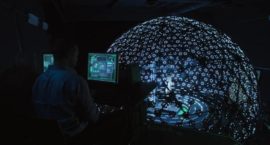If Holy Motors is Leos Carax’s dream of cinema, then The Congress is Ari Folman’s nightmare on the same subject. In the little critical discourse on the film that has appeared so far, that comparison has almost become cliché, but I do think it is interesting. Superficially, both films seem to be about acting and actors, but that is a quite limiting perspective to take. Both, rather, deal with cinema as a whole, as a constantly evolving entity where technology dictates the rule of the day, for better or worse. Liberating as well as reifying or alienating, the technology of cinema is what both films have constructed their discourse around.

Narrative clarity is not something that either Carax or Folman seem to be particularly interested in. Holy Motors might as well be described as a surrealist series of vignettes framed as a dream while Folman seems to hitch a ride on the Yellow Submarine halfway through the film, plunging headfirst into a wild cascade of psychedelic animation sequences.
The first half of The Congress focuses on the family relations of a character called Robin Wright, played by real-life actress Robin Wright. I think it is important to make this distinction for a number of reasons. The world that is presented to us at the start of the film is not our own world, though there are a number of crucial similarities. This part of the film hinges on a sense of palpable near-future science fiction in the same vein as Alfonso Cuaron’s Children of Men. Other than in Cuaron’s film though, most of this world remains unspecified. The comparison might seem strange then because the most successful aspect of Children of Men is probably its world-building. Nevertheless the comparison seems valid to me because in one of the few moments that we actually get to see the real world in the second part of the film, its look feels especially inspired by the specific dystopian aesthetic of Children of Men except that we never really learn much about it or see much of it. This is probably due to the suggestion that the world of the fiction is more or less supposed to be the world we live in now. A seemingly inconsequential but important example to illustrate the relation between real and fictional is the name of the studio that Robin works for, Miramount. This could simply be taken as a gag, in which the names of two real-life studios are conflated. Or it could be a reflection on the continual evolution of the film industry. Historically, studios have been merging ever since the system started. That interpretation starts to seem less far-fetched as an awareness of the history of film as a business comes through in other parts of the film as well. The speech given by Harvey Keitel’s character, Al, to convince Robin to take the Miramount’s contract offering is especially reminiscent of the way studios handled their actors during Hollywood’s Golden Age. The contract involves Robin selling a scanned digital copy of herself to the studio, to do with as they please within certain contractual limitations. Robin initially protests, saying that she has a right to choose her own roles and make her own decisions in life. Al suggests that she never really had a choice anyway. While the resonance of the scene for our present cultural moment is clear, it reminded me even more of the way Hollywood worked in the ‘30s and ‘40s: actors were under long-term contracts with little or no input in the choice of their projects. Actors would basically show up when and where the studio wanted them to. Another reason to differentiate between the character and the real-life Robin, would be that the latter is not the ‘failure’ the film sets her up to be. She gets castigated by her manager for having made the decision to put her career on hold to look after her young son. Folman started this project in 2008 and since that time Robin Wright has had important parts in prominent productions like David Fincher’s remake of The Girl With The Dragon Tattoo (2011), Bennet Miller’s Moneyball (2011) or the Netflix series House of Cards.
So Robin signs the contract and gets scanned. That whole scanning sequence particularly rings true to me because of last year’s commotion surrounding the design of one of the main characters in the video game The Last of Us produced by the studio Naughty Dog. Ellen Page had jokingly commented about The Last of Us, one of the big gaming blockbuster releases of 2013, that she did not appreciate the likeness between herself and the character Ellie in the game. When it was announced that Page was actually working on a video game, people almost automatically assumed that this was The Last of Us, whereas it turned out that she was voicing the main character in David Cage’s Beyond; Two Souls along with Willem Dafoe. The comment that Page made (in a Reddit post of all things) got completely blown out of proportion and context by certain media, but the point still stands that Ellie might as well have been Ellen Page if nobody had said otherwise. Naughty Dog did make some changes to the final design of the character, supposedly to get closer to the intended personality. And it was not only Ellen Page who got digitalized these past few years. A ‘hologram’ of Tupac Shakur performed two songs during Coachella 2012. And there is also the suggestion that Philip Seymour Hoffman’s unfinished performance in the last Hunger Games film will be ‘completed’ by digitally recreating him. While we may not have not seen many controversial practices with digital versions of either dead or living performers yet, important boundaries are already being crossed. The creepiest thing here might be that a joking comment from Page leads to a lot of drama, while people seem to accept the Tupac and Hoffman appearances so easily. At the time of my writing this, the Youtube video I linked has more than 145.000 likes to just over 4.000 dislikes, which is about normal for a popular video of this size. The Fandor post only mentions the ethically worrisome nature of Hoffman’s possible digital recreation in passing, almost justifying it in the same sentence. The dead cannot complain. There are probably more examples but the point here is that the sci-fi idea of scanning an actor and selling the digital version is not so outlandish. If anything scanning actors has become common practice for big video games or CGI blockbusters. For the scanning scene, Folman was surprised when a location scout found a studio that actually did these things already. So the scanning room that we see in the film with the ball filled with blinding lights is actually real. I wonder if some viewers watching The Congress might not even consider this initial idea to be dystopian. Al’s monologue on the necessity of Robin taking this opportunity offered to her by the studio is eerily convincing after all.

About halfway through the film there is a 20-year time leap after which Robin enters a so-called animated zone. This is where the film switches from live-action to animation and narrative clarity takes a backseat to subjective states of mind informing the plot and look of the film. Interestingly, much of the critical writing on this film expresses the desire to have the rules be laid out and things to be explained in this animated zone. If there is anything wrong with big contemporary sci-fi movies, it is that everything has to be explained to the audience so extensively that we end up with a problematic amount of ill-handled expository dialogue. The Congress is guilty of this tendency in its live-action part, but considering that the film is a satire and it suddenly stops explaining itself after the 20-year time leap, I wouldn’t be surprised that this was intentional. Viewers may want these animation trips to be grounded in a clear reality, but the loss of reality is probably the film’s major theme, one it takes from its literary inspiration: The Futurological Congress by Stanislaw Lem. And although critics have complained that the film does not have anything to say beyond superficially referencing its themes, the sense of loss and disorientation you experience while watching this film is palpable. Only, as usual, some people accept the free-flowing feeling of surrealism while others get frustrated. Of course, when the film initially adheres to a rather normal narrative progression, you risk losing all emotional connection when the rules that governed the narrative world suddenly do not seem to apply anymore and figuring out the new ones might not even be possible. However, I think Folman manages to anchor this emotional connection through the mother-son relationship between Robin and Aaron. Aaron is introduced at the start of the film as having a serious disease that affects his eye-sight and hearing, to the point that he will eventually become deaf and blind. We see him flying a kite with dogs barking at him, and get some distorted audio that is focalized through his deficient senses. One of Robin’s reasons for not living up to the career potential she had in the 1990s is that she had to take care of her son. The recurring image of the son’s red kite is significant here. A friend got annoyed by this kite and described it as a facile symbol representing freedom or happiness. Although I think that this view is too narrow, the point about freedom is interesting. A kite needs a particular combination of circumstances to be able to fly. And then when it does fly, it always remains tethered to the person controlling it. Unleash it and its freedom is restricted to following the wind for a short while until it crashes. This interplay between freedom and restriction is at the heart of the film. Technology has been framed as both granting freedom and limiting it with respect to the actor’s control over her image and performance. Robin gets to do whatever she wants by selling her digital copy to the studio. She is free to do everything she did not have time for when she actually had to show up for work, everything but acting and performing, because that is not allowed through the contract she has signed.


Folman really wears his influences on his sleeve on this film. He has acknowledged the Lem influence for the second part of his plot, the loosely satirical set-up of a congress being held up, terrorist attacks occurring and a main character that floats between various drug-induced states of delusion and reality. This accounts for the initially rather strange but actually poignant merging of the pharmaceutical and entertainment industries. From the moment Robin enters the congress hall, the film is filled with little jokes and references hidden at the sides of the frame and at the back of the compositions. These kind of Tati-esque, overwhelmingly full compositions really encourage scanning the frame to catch as much of this play as possible. Unfortunately this heightened intertextuality also invites the viewer to make connections that might not be there or are a lot less interesting. For example, the strange decision to have two people constantly beating on drums during the big speech of the congress is a bit reminiscent of that awful rave scene in The Matrix Reloaded. Another acknowledged influence comes from 1930s Fleischer studios cartoons, the studio that gave us classic characters like Popeye and Betty Boop. This influence shows in the design of many of the characters when we first enter the congress in the animated zone, but everything about the big animated sequences with plenty of characters running through the frame suggests that they were drawn from many different styles, a plurality that reflects the idea of the subjectivity of experience and vision that mediates what goes on in the animated zone. The look of the world when she first enters the animation is very inspired by the 1960s Beatles animated feature The Yellow Submarine (1968). Then the architecture of the congress buildings starts to feel more like Japanese anime. This brings me to Satoshi Kon. In the 2000s he was one of the big directors working in feature film anime until his premature death in 2010. Satoshi was also preoccupied with delusional mental states and psychedelic animation. In relation to The Congress, I think especially his film Paprika (2006) should be mentioned. It is his only real science-fiction film and also features a female protagonist who navigates various dream and delusional states with similar moments of overwhelming aesthetic overload. It features a parade that runs through the whole film during which people turn into inanimate characters, from frogs playing instruments, to Buddha statues, to small Godzilla monsters, to creepy dolls, etc. This is very similar to what happens when people take the identity-changing drugs in The Congress and we see them change into various film and music stars, religious icons, political leaders, etc. This is one of the reasons why animation can be so great. Imagination is the only limitation.


I also like the switch to animation in The Congress because it muddles the idea of a straightforward critique of the effects of technological advancements in the film industry. Wouldn’t the decision to stay with live-action, as Carax does, have given the actors more range to act as opposed to making them voice-actors halfway through your film? Definitely, and behind this is the same logic that fronts Fleischer cartoons as an aesthetic reference point, the one specifically noted to the press. Fleischer is old-school, at the opposite end of the animation spectrum from contemporary CGI. But at the same time there is the fact that the film works hard to stress that digital technology grants the artist the freedom to put in his film whatever the imagination can conceive. The dialectic nature of Folman’s critique reminds me, in some ways, of Godfrey Reggio’s Koyaanisqatsi. Not because of any aesthetic similarity but rather because of the idea that by subverting your premise or message, intentionally or not, through the aesthetic choices you make, in many cases makes for better cinema. Koyaanisqatsi is a better movie than the similar Baraka, becauseits ecological message becomes muddled along the way when the movie becomes as much city symphony as nature documentary. In The Congress there is a deep sense of loss and disorientation but also one of overwhelming imaginative possibilities. Folman’s nightmare is hopeful.